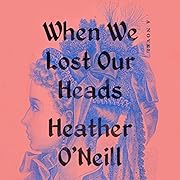On many levels, I really liked this book. I'm pretty sure it'll be on my best of reads for 2022.
I went into When We Lost Our Heads with much anticipation of a new Heather O'Neill book. I first read Lullabies for Little Criminals, and I didn't quite get it. I liked it, but it was so outside my experience and comfort zone. Next was The Girl Who Was Saturday Night, and by now, I get her storytelling, and I like being along for the ride. By the time I read The Lonely Hearts Hotel, I moved Heather O'Neill onto my favourite author list.
Two young girls in late 1800s Montreal meet and have a immediate connection. Marie Antoine is the daughter of a sugar baron, and Sadie Arnett is the daugher of social/political climbers and they both live on the Golden Mile. It's a dangerous, passionate friendship between the girls. Dark things happen and the girls are separated, but still obsessed with each other. (The dark thing will come back later in the book - the plotting and twists were exquisite!) In my head I'm thinking that Marie Antoine sounds a lot like Marie Antoinette.
The main part of the story comes after Sadie returns to Montreal and the girls are reunited. Marie is super rich and powerful and Sadie is a little darker and twisted. I loved that the book was nearly all female characters. You know the Bechdel test? It's "a measure of the representation of women in fiction. It asks whether a work features at least two women who talk to each other about something other than a man. The requirement that the two women must be named is sometimes added." Well this book passes with flying colours. The males are few and far between - Marie's father Louis and Sadie's brother Phillip are mentioned but not much else.
I looked up for some information about the book while I was reading it, and found a review which pointed out some connections between the French Revolution and the book. I didn't figure this all out myself, but I had noticed the Marie Antoine part.
Louis Antoine (Louis XVI); Marie Antoine (Marie Antoinette); Sadie Arnett (Marquis de Sade); Mary Robespierre (Maximilien Robespierre); Jeanne-Pauline Marat (Jean-Paul Marat); and George Danton (Georges Danton).
About this point I really think about the title and notice the cover picture. D'oh! The second half of the book sets up the revolution, with the female factory workers and the agitators. Everything is about the women - gender roles, women workers, contraception and childbirth, and expectations about women are defined continuously, while Marie and Sadie are not living according to expectations.
So I loved the French Revolution parallels (even though I know so little about French Revolution), I loved the feminism, I loved the writing, and I loved twists and turns that I did not see coming. Let them eat cake indeed.

No comments:
Post a Comment
Thanks for commenting, so nice of you to visit.
(I'll try without the letters for a while - so please dont be a spammer! Let's try no anonymous users)